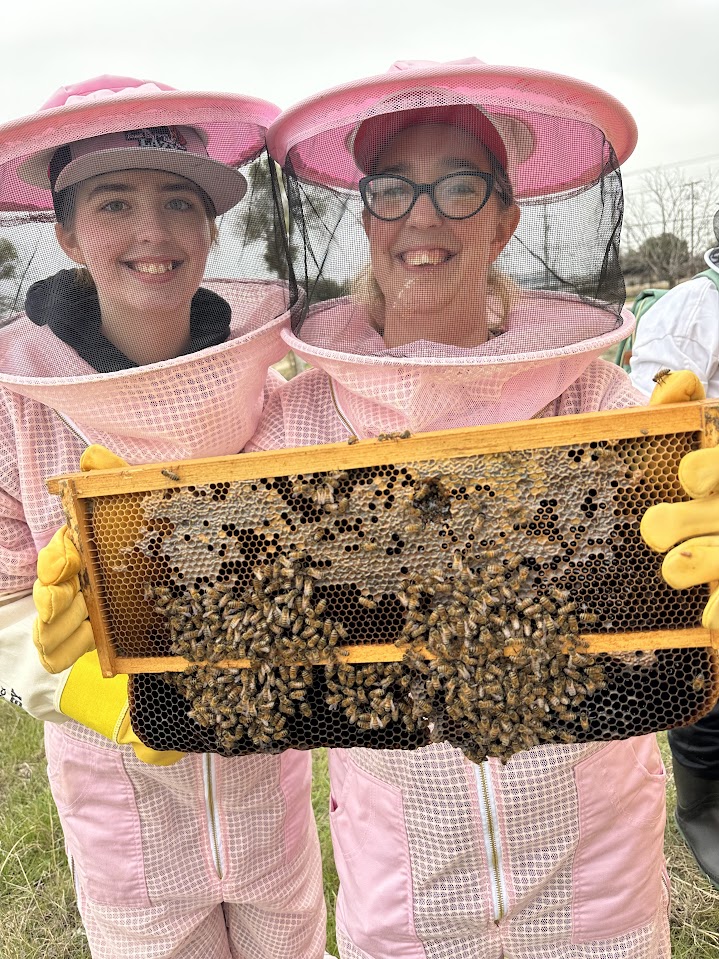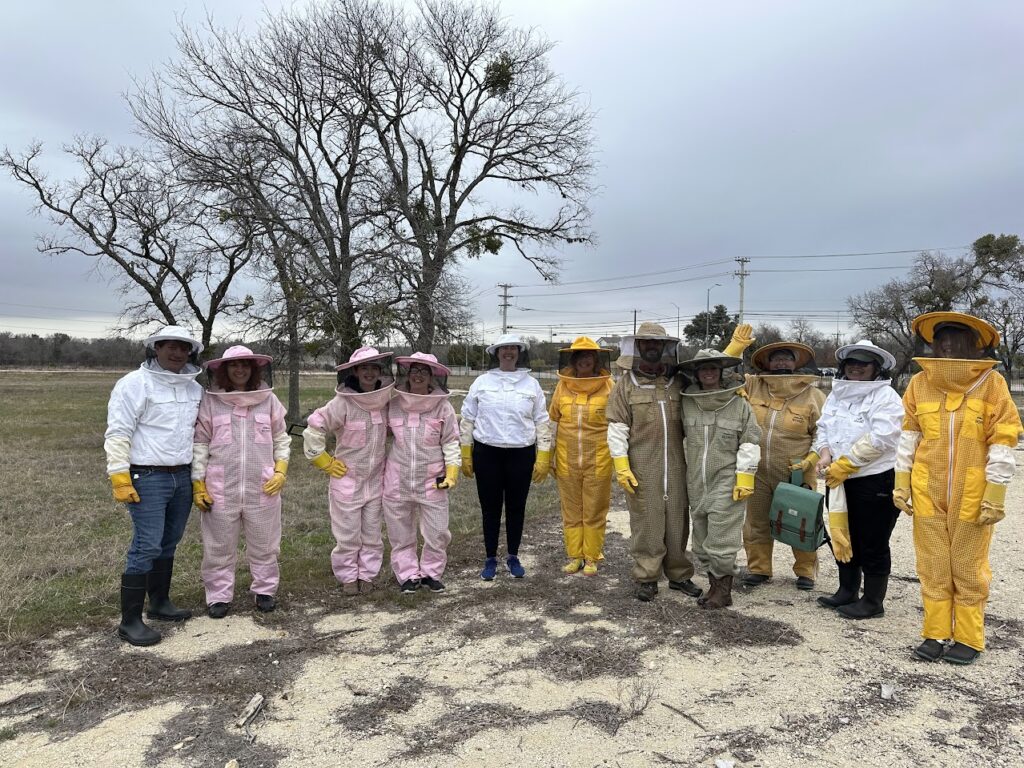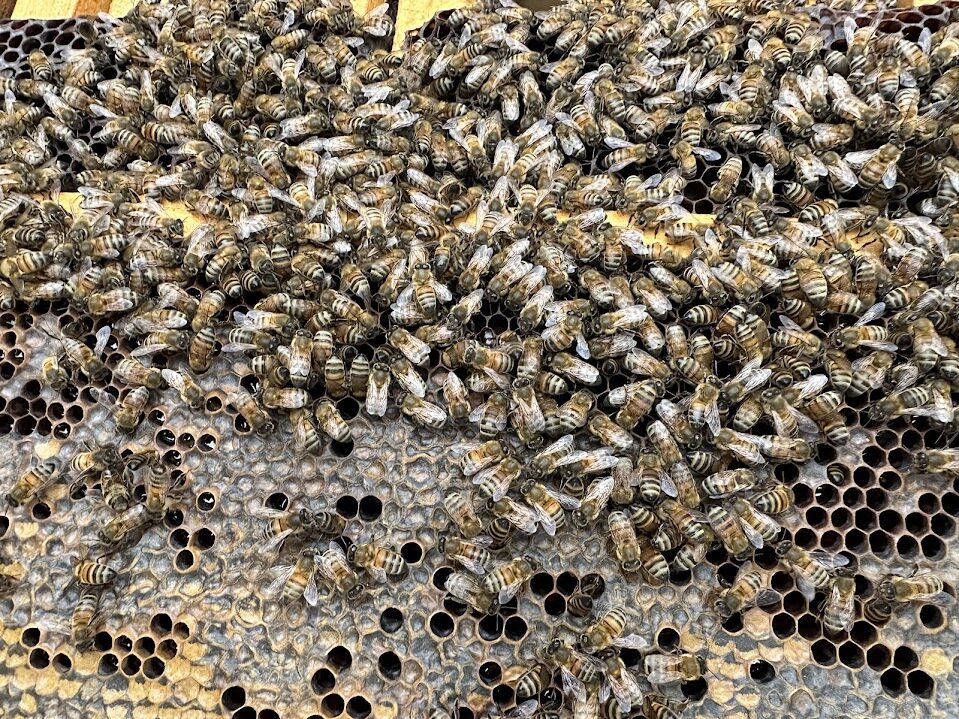Bee-Keeping Class: 11 Interesting Things We Learned
One of the most exciting things about having a farm for me is the idea of keeping bees. To achieve this goal, Breanna and I went to a bee-keeping class hosted through Round Rock Honey.
We learned about the bee’s bodies, how they are designed to do their tasks, and how to properly care for them. Once it warmed up a bit (although it was still only forty-eight degrees outside), we could look at the hives and see the bees ourselves.
Why Do Bees Sting You & How to Care for a Wound
One of the first things we learned at the bee-keeping class was that bees don’t sting out of spite but as a defense mechanism. When a honeybee feels threatened, it uses its stinger as a last resort.
The catch? Honeybees have barbed stingers, meaning once they sting, the stinger gets stuck, pulling part of their abdomen with it. Unfortunately for the bee, this is a one-time event, as they don’t survive after stinging. Other stinging insects, like wasps, have smooth stingers and can sting multiple times.
If you get stung, the key is to remove the stinger quickly and correctly to minimize pain and swelling. We were told the best way to remove the stinger is to use a credit card to scrape it out the same way it went in. Just slide the edge of the card across your skin to lift and remove the stinger without extra pressure.
Once the stinger is out, wash the area with soap and water, then apply a cold compress to reduce swelling. If you react strongly to stings, taking an antihistamine can help. And, of course, if you experience difficulty breathing, dizziness, or swelling beyond the sting site, seek medical attention immediately.
Fascinating Facts We Learned At the Bee-Keeping Class
How Bees Turn Nectar into Honey
When bees collect nectar from flowers, they don’t just store it away—they begin the honey-making process right in their mouths.
Konrad, the teacher (and owner of Round Rock Honey) taught us in the bee-keeping class that a forager bee sucks up nectar using its proboscis (a straw-like tongue) and holds it in a special honey stomach, separate from its digestive stomach. Once back at the hive, the bee passes the nectar to another worker bee by regurgitating it into her mouth.
This process is repeated 20 to 30 times, with each bee adding enzymes that help break down complex sugars into simpler ones, making the nectar more digestible and less likely to spoil.
As the nectar continues to be passed around, it transforms into honey. At this point, though, it’s still too watery. The bees store it inside hexagonal honeycomb cells (that are actually cylinder-shaped when the bee creates it, but that’s another story) and begin fanning it with their wings to speed up evaporation. This process removes excess moisture, thickening the liquid into the golden, sticky honey we all know and love.
Once the moisture content drops to around 18%, the bees seal the honeycomb with a thin layer of wax to keep it fresh for future use.
In the bee-keeping class, we learned that honey isn’t just food for us—it’s critical for the hive’s survival. Bees rely on it as their primary energy source, especially during colder months when flowers aren’t blooming. A single bee only makes about 1/12th of a teaspoon of honey in her lifetime, so the next time you drizzle some in your tea, think about how much effort went into every drop!
A Bee’s Loyalty to One Flower
When a bee finds a good nectar source, she doesn’t just flit from flower to flower at random. Instead, she commits to repeatedly working on the same flower until it has nothing to give. This behavior, called floral fidelity, ensures the most efficient collection of nectar and pollen.
Floral fidelity is essential because it helps keep pollen transfer efficient. Imagine if bees constantly jumped between different types of flowers—pollen from a sunflower wouldn’t do much good for an apple blossom. Bees increase the chances of successful pollination by sticking to the same type of flower on each foraging trip, which helps plants produce fruit and seeds. Once a particular flower patch is depleted, the bee will move on and repeat the process with a new type of bloom.
This single-minded dedication means bees are incredibly efficient pollinators, and it’s one of the reasons they’re so vital to ecosystems and agriculture. Many crops, including almonds, blueberries, and cherries, depend almost entirely on bees to pollinate them. So, the next time you see a bee hovering around a flower, know she’s on a mission!

What a Beehive Consists of
One interesting thing we learned in the bee-keeping class was that every member has a specific role in keeping the colony thriving.
A typical hive consists of one queen, 5-10% drones (males), and around 30,000 worker bees. Each type of bee looks and behaves differently, and each plays a vital role in the hive’s survival.
drones
Drones, the male bees, are easy to spot. They have rounder, hairier bodies, and no stingers, meaning they can’t defend the hive.
Their main job? Mating with a queen from another colony to ensure genetic diversity.
But life as a drone isn’t all that sweet. Since they don’t collect nectar or pollen, they rely on workers to feed them.
If a hive has too many drones consuming resources, the worker bees will kick them out—especially before winter when food needs to be conserved.
If you ever notice black specks on a drone’s body, those are parasitic mites, which can weaken bees and spread disease throughout the hive.
One thing I liked about learning this information is that if there are too many or they get parasitic mites, you can feed the drones to your chickens. I know my girls would be very excited!worker bees
The worker bees—the smallest but busiest members—comprise most of the colony.
They’re about one inch long and handle everything from foraging to guarding the hive and caring for young bees. Without them, the hive wouldn’t function. These are the girls that make the food for the hives- and us!
queen bee
Then there’s the queen bee, the mother of the colony. She’s easy to recognize thanks to her larger abdomen, which holds her reproductive system. We spent some extra time outside in the bee-keeping class to look for her.
Unlike the calm, organized workers, the queen always runs around in a hurry. She has one mission: laying eggs—and lots of them. Using her tail, she pushes out up to 2,000 eggs daily, ensuring the hive stays populated. While in charge of reproduction, she doesn’t actually “rule” the hive—the worker bees take care of her, feeding and grooming her to keep her going.
How to Keep Your Beehive Healthy
A strong, thriving beehive doesn’t just happen—it takes careful management, especially since bees are highly susceptible to parasitic infections and other environmental stressors.
One of the biggest factors in a hive’s health is the queen bee. A good queen means a strong colony because she lays the eggs that will become the next generation of worker bees. Without a productive, healthy queen, the hive population dwindles, and the colony can struggle to survive.
Checking on Your Queen Bee
You can tell if your queen is doing well by watching how the other bees react to her. One simple test is to lay her gently on top of the hive and see if the worker bees immediately gather around her, covering her. This is a good sign—they’re recognizing and protecting her, which means the colony accepts and respects her.
If the workers seem disinterested or aggressive toward her, she may be weak, old, or failing to lay enough eggs (low hormones), which could indicate it’s time to replace her.
Another way to check her fertility is to look for tiny white pieces resembling rice grains in the hive. These are bee eggs, and their presence means your queen is actively laying and keeping the colony’s population stable. If you don’t see many eggs or notice erratic laying patterns, your queen may not be strong enough to sustain the hive, leaving the colony vulnerable to collapse.
Protecting the Hive from Parasitic Infections
Even with a strong queen, hives are at risk for parasitic infections, especially Varroa mites. These tiny parasites latch onto bees, feeding their fat stores and spreading deadly viruses. If left unchecked, Varroa mites can wipe out an entire hive.
A well-managed hive with a healthy, fertile queen and regular parasite checks will be stronger, more productive, and better equipped to survive the changing seasons.

Outside Things to Consider With Your Bees
Keeping bees happy and productive isn’t just about what happens inside the hive—their environment plays a huge role in their well-being.
While bees are resilient creatures, small changes in their surroundings can make a big difference in their health, hydration, and overall contentment. Two of the most important factors? Access to wet soil and a reliable water source.
The Importance of Wet Soil for Bees
The most content and thriving bees have access to wet soil. Why? Because it provides essential minerals and nutrients that they instinctively seek out. Just like how humans need a balanced diet, bees require minerals beyond just nectar and pollen to maintain their strength and immune systems. Wet soil offers a natural mineral source, which they absorb when drinking water or collecting mud.
Additionally, bees sometimes use damp soil to regulate hive humidity, especially in hot weather. Worker bees will bring tiny droplets back to the hive and use their wings to fan and distribute moisture, keeping the temperature stable. If you’re keeping bees, consider keeping a shallow patch of damp soil nearby, especially during dry seasons when natural sources might be scarce.
Why Running Water is Better for Bees
Bees prefer running water over stagnant pools when it comes to drinking water. A moving water source, such as a shallow stream, dripping fountain, or even a slow hose leak, prevents bacterial buildup and stays fresh longer.
Standing water, like puddles or birdbaths, can harbor harmful bacteria, algae, or pesticides that could be carried back to the hive, affecting the entire colony. We were also told in the bee-keeping class that if they use this water source, they will spend more time cleaning themselves than making honey, and both humans and the bees would prefer the former to happen instead of the latter.
If you don’t have a natural water source, you can create one by setting up a shallow dish with fresh water and small floating objects like corks, stones, or wood for the bees to land on safely. Just remember to refill it often—once bees find a reliable water source, they’ll return to it consistently, and keeping it fresh ensures they stay hydrated and healthy.
Want to know more about our farming? Check everything about how we're handling our garden here!
What was the Bee-Keeping Class like
The bee-keeping class was fun and informative. We spent a portion of the time inside learning and a portion of it outside getting hands-on with the bees.
I am still a little nervous about it, but Konrad and Elizabeth were so friendly- they said if we have any questions, we should email them, and they will help with what they can.
I cannot recommend going to this class enough if it is something you are interested in!
What We Plan to Do with the Information From the Bee-Keeping Class
Breanna and I will purchase our NUCs later next week or in the fall. What’s really awesome is that we get the full super hive and a colony ready to go. Round Rock’s bees come with a 97% success rate, which makes me feel even better.
Needless to say, we are so excited for this adventure with our new friends and, after taking the class, are a lot less scared of them!
